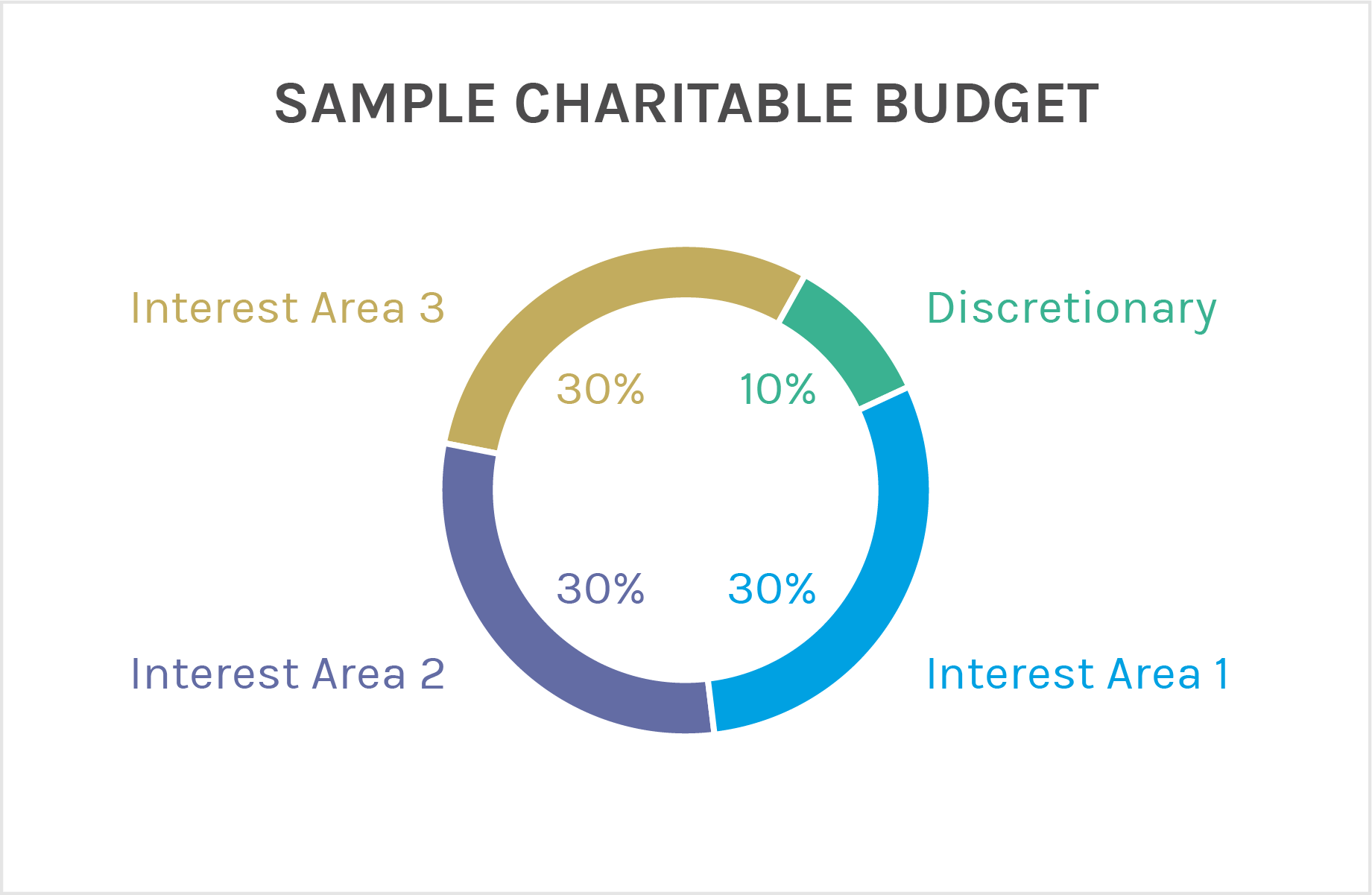By combining your charitable gifts with volunteer efforts, you can have a meaningful impact on causes you care about even if you don’t have a lot of money to give away.
Most people I work with at Morgan Stanley are focused on helping clients grow their money; my job is to help them give it away.
In my daily life, I’ve spoken to many people who think charitable giving isn’t for them because they’re not wealthy enough. While eight-figure charitable gifts might make the news, most donations are much smaller. If people didn’t give at lower increments as well, most charities would really suffer.
There really is strength in numbers.
Here’s how you can make a real difference—even if you’re not a millionaire:
Step 1: Find Your Focus
My primary area of interest is education. In addition to supporting my alma mater, Villanova, I donate time and money to organizations that work on college readiness and mentorship.
As a student, I was heavily involved with the Special Olympics Fall Festival, so as an alumnus I designate my annual gift to Villanova’s Special Olympics fund. During my four years there, I volunteered as a Local Program Host and info booth attendant to ensure that athletes got to their events on time and accessed all of the programs available to them—Healthy Athletes, for example, offered free checkups with nursing students and local doctors. That weekend was easily my favorite weekend on campus every year, and it’s one of the main reasons I give to my alma mater and designate my gift to this program in particular.
My interest in education also stems from another volunteer program I participated in as an undergrad. Senior year, as part of a Service Learning Community, I tutored at a high school in Philadelphia where some high school seniors were reading at an eighth-grade level. That was a shock to my system and ultimately steered me toward making education my main charitable focus.
Are you passionate about the arts? Civil rights? The environment? I recommend limiting yourself to no more than three core areas to avoid stretching yourself too thinly.
On top of your “official” areas of interest, you may wish to set aside 10% of your charitable budget for discretionary giving. Maybe you want to support a friend’s cancer research walk-a-thon even though health isn’t your focus area; maybe you like donating to your alma mater even though education isn’t specifically your thing.

Step 2: Think About the 3 Ts
Decide early on what your philanthropic budget will be for the year. That includes money as well as time and energy.
I think of philanthropic resources in three buckets:
- Time: The time you can dedicate to volunteer work
- Talent: The specialized skills you can offer to an organization
- Treasure: The money you’re able to donate
In addition to contributing “treasure,” I personally focus a lot on “time” and “talent.” At my day job, I help nonprofit clients with their fundraising strategies, so I leverage that experience with the organizations I support. When there’s a phone-a-thon at my old high school, I’ll share techniques with other volunteers so they’re more successful at garnering donations. If you’re a computer engineer, you might help a nonprofit with its technology; if you work in marketing, you might review new capital campaign brochures; if you work in finance, you might help develop a budget for a fundraiser.
Be open from the outset about how much time you’ll be able to dedicate. My high school knows I’m only free on weekends, even though the majority of their phone-a-thon sessions occur on weeknights. They don’t begrudge that, because I’ve been upfront about my availability and I make it count when I am there.
Step 3: Make a List of Organizations
Compile a list of interesting organizations in your focus areas.
Donating to Villanova was an easy decision for me because it had such a large impact on my life. Depending on your focus area, cast a wide net—if you care about international aid, compile a list of organizations across a spectrum such as refugee assistance, disaster relief, medical aid, human rights advocacy, or education reform, and then decide what resonates most with you.
Great resources include GuideStar and Charity Navigator, where you can learn about each charity’s programs, size, impact, awards, financials and more. I recommend identifying five to ten target organizations so you have a robust list to whittle down.
Step 4: Reach Out
Some opportunities find you, while other times you have to seek them out. I actively reached out to Villanova’s admissions office because I wanted to help interview students for potential scholarships. Meanwhile, I got involved with Villanova’s alumni network when I received an invitation to participate in a pilot mentorship program in which sophomores would be paired with alumni who would mentor them through graduation.
Nonprofits will rarely say no to speaking with someone who’s interested in learning more, even if that person isn’t a big-money donor. Plus, a lot of organizations recognize that younger donors, especially, offer fresh perspectives and diverse skill sets—and, perhaps most importantly—broad personal and professional networks where they can spread the word.
If you’re not sure whom to reach out to at an organization, do some online research. In my case, I looked up who in Villanova’s admissions office helps run the Alumni Interview program and I sent that person an email. It’s just a matter of not being afraid to ask questions and put yourself out there.
Ask each charity about its short- and long-term goals. What progress has it made toward its goals so far? Does this seem like a trustworthy organization? Do its programs make sense to you? Does it seem well-run and organized?
Step 5: Define the Details
Identify specific programs you’re interested in contributing to, and think about the size of your gift or time commitment.
For example, I allocate my annual monetary gift to Villanova to the Special Olympics. The details of my volunteer work are just as clear and defined: Each year, I commit to interviewing a certain number of students, usually three to five. That’s toward the bottom of the requested range, but realistically, I couldn’t do the students or the university justice if I signed up for more than that.
While you can fund specific programs, it is important to remember that organizations need unrestricted gifts to survive. If you believe in the charity, it has a demonstrated track record, and is fiscally sound and well managed, then you might want to make a donation for general operating support. This will help the charity keep the lights on, pay staff and maintain stable operations.
Step 6: Give to Charity!
No matter whether you are giving time, talent or treasure, this is the most rewarding part!
Step 7: Stay Engaged
I’m always trying to get my friends involved. When I go back to campus for the Special Olympics Fall Festival, I’ll send a message to any friends in the area saying, “I’ll be in town. Want to meet on campus? We can volunteer during day and hang out at night.” It’s a way to reconnect with friends and encourage charitable giving at the same time.
Engagement is part of being an active philanthropist. The first step is to follow up. If you gave to a specific program, ask how it went. If your $500 gift provided supplies for one student at one summer camp, ask, “How did camp go this year? How many kids attended? Was there a survey conducted to gather tangible metrics to show the efficacy of that program?”
If you donated toward general operating support, review the annual report when it comes out. Look at how much of the organization’s funding went toward programmatic expenses as opposed to administration or how much the organization spent on fundraising efforts to raise each dollar. Try to determine the impact of the organization’s work that year.
Beyond that, share your passion for the organization. Even if you’re not a millionaire, you can help amplify the effect of your giving by encouraging others to get involved and by spreading the word about how the organization is making a difference in the world.

Morgan Stanley Smith Barney LLC (“Morgan Stanley”), its affiliates and Morgan Stanley Financial Advisors and Private Wealth Advisors do not provide tax or legal advice. Clients should consult their tax advisor for matters involving taxation and tax planning and their attorney for matters involving trust and estate planning, charitable giving, philanthropic planning and other legal matters.
The article is provided for informational purposes only. The information and data in the article has been obtained from sources outside of Morgan Stanley Smith Barney LLC (“Morgan Stanley”) and Morgan Stanley makes no representations or guarantees as to the accuracy or completeness of information or data from sources outside of Morgan Stanley.
Morgan Stanley Smith Barney LLC is not implying an affiliation, sponsorship, endorsement with/of the third party or that any monitoring is being done by Morgan Stanley Smith Barney LLC (“Morgan Stanley”) of any information contained within the website. Morgan Stanley is not responsible for the information contained on the third party website or the use of or inability to use such site. Nor do we guarantee their accuracy or completeness.
Further, this material should in no way be considered to be a solicitation or endorsement by the Morgan Stanley on behalf of organizations named. If you choose to support the subject organization, or any other organization that you separately identify, we recommend that you evaluate the organization, and make your own independent decision as to its legitimacy and merits.
Information contained herein is based on data from multiple sources considered to be reliable and Morgan Stanley Smith Barney LLC (“Morgan Stanley”) makes no representation as to the accuracy or completeness of data from sources outside of Morgan Stanley.
© 2020 Morgan Stanley Smith Barney LLC
CRC#3124593 (06/2020)




No comment yet, add your voice below!